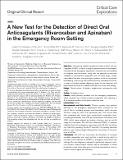A New Test for the Detection of Direct Oral Anticoagulants (Rivaroxaban and Apixaban) in the Emergency Room Setting
Author(s)
Frydman, Galit H.; Ellett, Felix; Van Cott, Elizabeth M.; Hayden, Douglas; Majmudar, Maulik; Vanderburg, Charles R.; Dalzell, Haley; Padmanabhan, Divya L.; Davis, Nick; Jorgensen, Julianne; Toner, Mehmet; Fox, James G; Tompkins, Ronald G.; ... Show more Show less
DownloadPublished version (975.3Kb)
Publisher with Creative Commons License
Publisher with Creative Commons License
Creative Commons Attribution
Terms of use
Metadata
Show full item recordAbstract
Determining whether a patient has taken a direct oral anticoagulant (DOAC) is critical during the periprocedural and preoperative period in the emergency department. However, the inaccessibility of complete medical records, along with the generally inconsistent sensitivity of conventional coagulation tests to these drugs, complicates clinical decision making and puts patients at risk of uncontrollable bleeding. In this study, we evaluate the utility of inhibitor-II-X (i-II-X), a novel, microfluidics-based diagnostic assay for the detection and identification of Factor Xa inhibitors (FXa-Is) in an acute care setting. Design: First-in-human, 91-patient, single-center retrospective pilot study. Setting: Emergency room. Patients: Adult patients admitted into the emergency department, which received any clinician-ordered coagulation test requiring a 3.2% buffered sodium citrate blood collection tube. Interventions: None. Measurements and Main Results: Plasma samples from patients admitted to the emergency department were screened for the use of FXa-Is, including apixaban and rivaroxaban, within the past 24 hours using our new i-II-X microfluidic test. i-II-X results were then compared with results from conventional coagulation tests, including prothrombin time (PT) and international normalized ratio (INR), which were ordered by treating clinicians, and an anti-Xa assay for rivaroxaban. The i-II-X test detected DOACs in samples collected from the emergency department with 95.20% sensitivity and 100.00% specificity. Unlike PT and INR, i-II-X reliably identified patients who had prolonged clotting times secondary to the presence of a FXa-I. Conclusions: The i-II-X test overcomes the limitations of currently available coagulation tests and could be a useful tool by which to routinely screen patients for DOACs in emergency and critical care settings. Our new diagnostic approach is particularly relevant in clinical situations where medical records may be unavailable, or where precautions need to be taken prior to invasive interventions, such as specific reversal agent administration.
Date issued
2019-08Department
Massachusetts Institute of Technology. Division of Comparative Medicine; Massachusetts Institute of Technology. Department of Biological EngineeringJournal
Critical Care Explorations
Publisher
Ovid Technologies (Wolters Kluwer Health)
Citation
Frydman, Galit H. et al. "A New Test for the Detection of Direct Oral Anticoagulants (Rivaroxaban and Apixaban) in the Emergency Room Setting." Critical Care Explorations 1, 8 (August 2019): e0024. © 2019 The Authors
Version: Final published version
ISSN
2639-8028